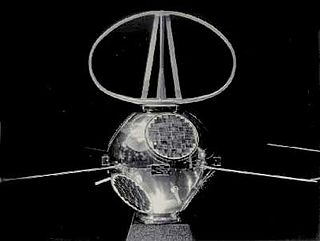NEXTSat, or Next Generation Satellite and Commodities Spacecraft (NEXTSat/CSC) is an American technology demonstration satellite which was operated as part of the Orbital Express programme. It was used as a target spacecraft for a demonstration of autonomous servicing and refueling operations performed by the ASTRO satellite. Launched in March 2007, it was operated for four months, and then deactivated in orbit.
Kosmos 36, also known as DS-P1-Yu #1 was a satellite which was used for use in calibrating the Dnestr space surveillance and as a radar calibration target, for tests of anti-ballistic missiles. It was launched by the Soviet Union in 1964 as part of the Dnepropetrovsk Sputnik programme. It was built by the Yuzhnoye Design Bureau.
Kosmos 76, also known as DS-P1-Yu No.3 was a Soviet satellite which was used as a radar calibration target for tests of anti-ballistic missiles. It was built by the Yuzhnoye Design Bureau, and launched in 1965 as part of the Dnepropetrovsk Sputnik programme.
Kosmos 101, also known as DS-P1-Yu No.4 was a Soviet satellite which was used as a radar calibration target for tests of anti-ballistic missiles. It was built by the Yuzhnoye Design Bureau, and launched in 1965 as part of the Dnepropetrovsk Sputnik programme.
Kosmos 116, also known as DS-P1-Yu No.6 was a Soviet satellite which was used as a radar calibration target for tests of anti-ballistic missiles. It was built by the Yuzhnoye Design Bureau, and launched in 1966 as part of the Dnepropetrovsk Sputnik programme.
Kosmos 123, also known as DS-P1-Yu No.5 was a Soviet satellite which was used as a radar calibration target for tests of anti-ballistic missiles. It was built by the Yuzhnoye Design Bureau, and launched in 1966 as part of the Dnepropetrovsk Sputnik programme.
Kosmos 165, also known as DS-P1-Yu No.11 was a radar calibration target satellite which was used by the Soviet Union for tests of anti-ballistic missiles. It was a 400 kilograms (880 lb) spacecraft, which was built by the Yuzhnoye Design Office, and launched in 1967 as part of the Dnepropetrovsk Sputnik programme.

TDRS-6, known before launch as TDRS-F, is an American communications satellite, of first generation, which is operated by NASA as part of the Tracking and Data Relay Satellite System. It was constructed by TRW, and is based on a custom satellite bus which was used for all seven first generation TDRS satellites.
Kosmos 173, also known as DS-P1-Yu No.8 was a Soviet satellite which was used as a radar calibration target for tests of anti-ballistic missiles. It was a 325 kilograms (717 lb) spacecraft, was built by the Yuzhnoye, and launched in 1967 as part of the Dnepropetrovsk Sputnik programme.
Kosmos 176, also known as DS-P1-Yu No.10 was a Soviet satellite which was used as a radar calibration target for tests of anti-ballistic missiles. It was a 400 kilograms (880 lb) spacecraft, was built by the Yuzhnoye Design Office, and launched in 1967 as part of the Dnepropetrovsk Sputnik programme.

TDRS-7, known before launch as TDRS-G, is an American communications satellite, of first generation, which is operated by NASA as part of the Tracking and Data Relay Satellite System. It was constructed by TRW as a replacement for TDRS-B, which had been lost in the Challenger accident, and was the last first generation TDRS satellite to be launched.
Kosmos 191, also known as DS-P1-Yu No.9 was a Soviet satellite which was used as a radar calibration target for tests of anti-ballistic missiles. It was built by the Yuzhnoye Design Office, and launched in 1967 as part of the Dnepropetrovsk Sputnik programme.
OPS 3762, also known as FTV-2355, was an American reconnaissance satellite which was launched in 1964. It was the first radar imaging satellite to be launched, and the only Quill spacecraft to fly. Its mission was to demonstrate radar imaging techniques for future missions. However, the programme was cancelled before any more satellites were launched.
FTV-2203, also known as Samos 5, was an American reconnaissance satellite launched in 1961 as part of the Samos programme. It was a film return reconnaissance spacecraft, meaning that it returned images in a film capsule at the end of its mission. FTV-2203 was a Samos-E5 spacecraft, based on the Agena-B. It carried a camera with a focal length of 1.67 metres and a resolution of 1.5 metres.

Transit 3B was an American satellite which was launched in 1961 and operated by the United States Navy. It was a replacement for Transit 3A, which was lost in a launch failure the previous year. It carried instruments to demonstrate navigation and timing systems, and study geodesy to support the development of the Transit satellite navigation system.

LOFTI-1 was an American satellite which was launched in 1961 and operated by the United States Navy and Naval Research Laboratory. It was used to conduct research into the propagation of very low frequency radio signals in the ionosphere, and to investigate if these signals could be received by submarines. A 136.17 MHz transmitter was used for this investigation.
Kosmos 24 or Zenit-2 No.15 was a Soviet optical film-return reconnaissance satellite. It was a first generation, low resolution spacecraft. A Zenit-2 satellite, Kosmos 24 was the fifteenth of eighty-one such spacecraft to be launched and had a mass of 4,730 kilograms (10,430 lb).
Tempsat-1 was a United States Navy Radar calibration object, launched from Vandenberg Air Force Base on a Thor Ablestar on August 13, 1965. It was a 14 inches (36 cm), unguided sphere. It was mainly used in investigation of spacecraft technology and orbits.

RADCAL was a radar calibration satellite launched and operated by the United States Air Force. It was active from June 1993 until it stopped communicating in May 2013.






